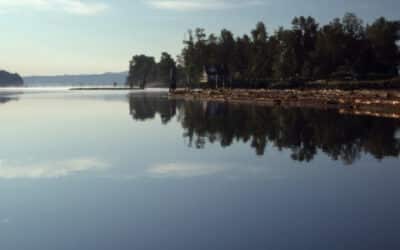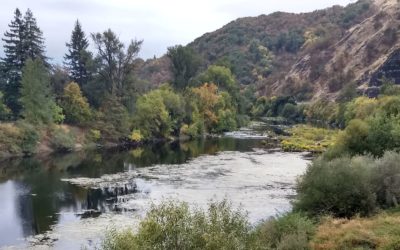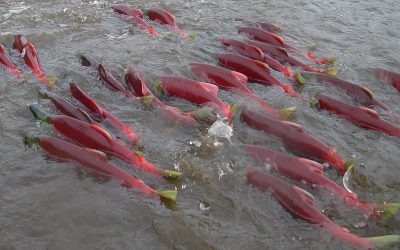Providing Salmon with Thermal Refuge from Hot River Temperatures
NWEA Forces Regulatory Agencies to Address Salmon Needs
Hot water stresses and kills cold-water fish such as salmon, steelhead, and bull trout. The concept of providi
The Agencies Rely on the Thermal Refuge Concept to Meet the Clean Water Act
Some rivers, such as the Columbia and Willamette mainstems, are believed to have historically been too hot for salmon migrating in summer temperatures. It has been assumed that these salmon survived warm river temperatures by moving from one thermal refuge to another. Such refuges could be provided by the input of a cooler tributary, an influx of cold groundwater, or hyporheic flow (a place in the streambed where groundwater and surface water mix). For this reason, in 2003, following NWEA’s first successful lawsuit challenging Oregon’s unprotective water quality standards for temperature, the U.S. Environmental Protection Agency (EPA) Region 10 instructed Northwest states that they could adopt a too-hot 20°C (68°F) numeric criterion to protect migrating salmon so long as the states also provided sufficient cold water refuges for those salmon. Oregon was ordered to adopted new standards, which included this critical protection, and EPA approved them in 2004.
The Agencies Do Nothing to Actually Provide Thermal Refuges for Salmon
In NWEA’s second lawsuit challenging EPA’s approval of Oregon’s temperature standards, we won a 2012 court order to fix the defective evaluation conducted by the federal agencies under the Endangered Species Act. As a result, in 2015, the National Marine Fisheries Service (NMFS) issued a new Biological Opinion evaluating the temperature standards. NMFS found exactly what we predicted: the Oregon Department of Environmental Quality (DEQ) had paid only lip service to the thermal refuge requirement and the EPA had ignored the state’s failure. EPA had told NMFS that it expected the thermal refuges would be identified in the development of Total Maximum Daily Loads (TMDL), science-based clean-up plans required by the Clean Water Act, as well as in NPDES discharge permits.
Nothing like that had happened. By this point, Oregon DEQ had issued numerous temperature TMDLs under a court order in another NWEA lawsuit, which allowed NMFS to see what had actually taken place, rather than to just rely on EPA and Oregon promises. The TMDLs demonstrated that Oregon DEQ had failed to identify thermal refuges, had failed to evaluate whether there were sufficient thermal refuges, and had provided no protection for any thermal refuges. In other words, the passage of time 
As a consequence, NMFS required EPA and DEQ to develop Cold Water Refugia Plans for the Columbia and Willamette Rivers that would assess whether sufficient refuges exist, what more is needed, and to “identify and prioritize potential actions needed to protect, restore or enhance” the refuges. The agencies were given three years to complete this process. Due in November 2018, neither EPA and DEQ has produced their plans.
As for EPA and Oregon DEQ’s promise to address the need for cold water refuges in NPDES discharger permits? Another epic fail. Instead or using permits to protect thermal refuges, Oregon DEQ decided to do the opposite and allow cities and towns to discharge treated sewage into rivers’ hyporheic zones. In 2013, NWEA pointed out the fallacy of this approach to EPA and we believe that it has come to a halt.
Lawsuit Forces EPA to Help Salmon Migrate a Hot Columbia River
After 18 years, and two NWEA lawsuits, the U.S. Environmental Protection Agency (EPA) has finally issued a draft plan to protect and restore cold water refuges to help salmon migrating through the hot waters of the Columbia River. NWEA recently submitted detailed...
Oregon Told Expedite River Cleanup Plans
Oregon and the U.S. Environmental Protection Agency (EPA) have eight years in which to replace defective water pollution clean-up plans that allow temperatures lethal to salmon in some of the state’s key river basins, a federal court ordered late Tuesday. U.S....
Court Rejects EPA Stand On Oregon Rivers’ Temperature
Oregon Rivers increasing temperatures need attention The U.S. Environmental Protection Agency (EPA) has a lot of work to do to protect salmon from hot water, according to a ruling issued by U.S. District Judge Marco A. Hernández Wednesday afternoon. The court...
Make Your Voice Heard
Become a Member
Donor Member
Yes, I want NWEA to represent my interests and I’m making a tax-deductible contribution!
|
|
|---|
Supporting Member
Becoming a member of NWEA doesn’t require a contribution. Show your support for our work sign-up as Supporting Member.



